- Quick Read
- Deep Read ( 5 Min. )

Why is Christian Science in our name?
Our name is about honesty. The Monitor is owned by The Christian Science Church, and we’ve always been transparent about that.
The Church publishes the Monitor because it sees good journalism as vital to progress in the world. Since 1908, we’ve aimed “to injure no man, but to bless all mankind,” as our founder, Mary Baker Eddy, put it.
Here, you’ll find award-winning journalism not driven by commercial influences – a news organization that takes seriously its mission to uplift the world by seeking solutions and finding reasons for credible hope.
Explore values journalism About usIn Today’s Issue
Monitor Daily Podcast
- Follow us:
- Apple Podcasts
- Spotify
- RSS Feed
- Download
TODAY’S INTRO
How reconciliation and forgiveness begin
 Mark Sappenfield
Mark Sappenfield
Today, I am going to be shamelessly promotional. This issue of the Daily includes a wonderful story on the difficulties of reparations, even when the motives are good. Germany and Holocaust is the case study.
But I’m going to encourage you to listen to this podcast, from our “Tulsa Rising” series several years ago about the race massacre there. It changed how I saw the issue by showing me what healing can look like. Honesty and genuine contrition not only begin to address the past but also begin to unlock the remarkable energies of a new future.
Share this article
Link copied.

Help fund Monitor journalism for $11/ month
Already a subscriber? Login

Monitor journalism changes lives because we open that too-small box that most people think they live in. We believe news can and should expand a sense of identity and possibility beyond narrow conventional expectations.
Our work isn't possible without your support.
Ukraine, Europe wonder: Has Putin outlasted the US?
America’s robust support for Ukraine has resonated across Europe and beyond. Yet as Congress holds up new aid, and Ukraine’s supplies dwindle, comes a question: Has the U.S. support shifted from “as long as it takes” to “as long as we could”?

The July 2022 delivery to Ukraine of the sophisticated American HIMARS multiple rocket launcher offered ironclad evidence that the United States would, in President Joe Biden’s words, stand with Ukraine “as long as it takes” to repel Russia’s aggression.
But these days, concerns are growing in Ukraine that the U.S. and some Western partners are tiring of the war Russian President Vladimir Putin launched nearly two years ago.
As Congress sits on a $60 billion Ukraine aid package that Mr. Biden first proposed in October, the idling of air defense systems due to a lack of ammunition is increasingly exposing Ukrainian cities to Russian missile strikes. Some military experts foresee rapidly deteriorating Ukrainian battlefield positions and even accelerating territorial losses in coming months.
Moreover, some predict dire consequences if Washington’s abandonment of Ukraine solidifies a global perception that the U.S. is an exhausted and divided superpower that no longer stands by its word.
“There’s no question that for at least a year, Putin’s strategy has been to wait out the U.S. and Europe,” says Mark Cancian at the Center for Strategic and International Studies in Washington. “So if we turn our back on Ukraine now it will be vindication of his thinking that in a conflict, the U.S. and NATO will eventually get tired.”
Ukraine, Europe wonder: Has Putin outlasted the US?

Ukrainian soldiers on the front lines of the war with Russia were jubilant when HIMARS, the U.S. Army’s coveted multiple rocket launcher, arrived on the battlefield in July 2022.
Not only was the launcher considered light-years ahead of the mostly Soviet-era equipment that the Ukrainians had at their disposal. But perhaps even more important, delivery of the sophisticated American weaponry offered ironclad evidence that the United States would, in President Joe Biden’s words, stand with Ukraine “as long as it takes” to repel the Russian aggression.
As recently as last week, a HIMARS rocket attack obliterated a group of elite Russian drone pilots operating in Ukraine’s eastern Donetsk province.
But these days, the HIMARS is also becoming a symbol of something else.
Amid stalled U.S. assistance, and a trickling supply of arms and ammunition, the launchers are reminders of how the U.S. and some Western partners are tiring of a war Russian President Vladimir Putin launched two years ago next month.
As Congress sits on a $60 billion Ukraine aid package that Mr. Biden first proposed in October, the idling of air defense systems due to a lack of ammunition is increasingly exposing Ukrainian cities to Russian missile strikes. And soldiers are running dangerously low on the ammunition that has enabled them to hold off the Russians.
An exhausted superpower?
For Ukraine, the outlook is increasingly sobering – with some military experts foreseeing rapidly deteriorating battlefield positions and even accelerating territorial losses in coming months.
Moreover, some predict dire consequences if Washington’s abandonment of Ukraine serves to solidify a global perception that the U.S. is an exhausted and divided superpower that no longer stands by its word.
“There’s no question that for at least a year, Putin’s strategy has been to wait out the U.S. and Europe, so if we turn our back on Ukraine now it will be vindication of his thinking that in a conflict, the U.S. and NATO will eventually get tired,” says Mark Cancian, a retired Marine Corps officer and a senior adviser with the International Security Program at the Center for Strategic and International Studies in Washington.
“And it won’t just be Moscow,” he says. “I think the Chinese, too, will conclude that if a war goes long, the U.S. will give up. The lesson for them and probably the Iranians might then be,” he adds, “if they start a war, they will have the advantage of endurance on their side.”
Not everyone agrees with the notion that a U.S. shift on Ukraine from “as long as it takes” to “as long as we could” will have significant global implications.
Rajan Menon, director of grand strategy at Defense Priorities, a realist foreign policy think tank in Washington, says he finds those concerns about China “far-fetched.”
The Chinese, he says, “are going to look at the balance of forces in their region and what the costs will be of launching a war, and less at how long the Americans stuck it out with Ukraine.”
Ukraine hostage to U.S. politics?
Yet virtually everyone from Kyiv and Western European capitals to Washington seems to agree on one thing. A drying up of U.S. military assistance would spell disaster for Ukraine’s aspirations of taking back and reestablishing sovereignty over any more of the nearly 20% of the country that Russia still occupies.
For months, congressional Republicans have tied up President Biden’s request for supplemental Ukraine aid in a battle over spending and toughening security measures at the southern border. A bipartisan solution to the border-Ukraine funding dispute floated by Senate leaders took another blow last week when former President Donald Trump called on his forces not to approve the proposal.

Speaker Mike Johnson declared Friday the plan would be “dead on arrival” in the House.
European political and military leaders – including British Conservatives who hoped to hold some sway with Trump-supporting Republicans – have been knocking on congressional doors in recent weeks with the message that not just Ukraine’s survival but Western Europe’s freedom is on the line.
“Definitely the leadership and the engagement of the U.S. in the long term, but also in this very important phase, is paramount,” says a European official in Washington. “The supplemental [U.S. funding] is a must-have to continue – not only on the ground,” the official adds, “but as a show of Western resolve ... to make [Mr. Putin] understand that he will not win.”
Mr. Menon, who has just returned from his fourth visit to wartime Ukraine, says that for the first time he found “a mood of great pessimism – not over their will or ability to fight this war with Russia, but over how they are now hostage to [U.S.] politics.”
The lack of ammunition is one factor in Ukraine’s shift to what military experts dub an “active defense” – meaning a hunkering down along defensive lines, with aerial attacks (weaponry permitting) aimed at disrupting Russian logistics lines.
But a halt to U.S. aid would mean that deliveries of munitions and weaponry would shrink even further, Colonel Cancian says – with the worst-case scenario being a “collapse” of Ukraine’s fighting capabilities, perhaps even this year.
“The ammunition and artillery delivered in January 2024 is already one-third of what it was in the summer of 2023,” he says. “Without a quick change, that’s going to be down to 8% by June,” he adds. “There’d be a pulling back [from defensive lines], and eventually you’d see a collapse.”
What Europeans are doing
Countering that grim picture is the more hopeful scenario offered by some analysts that Europe is taking steps to at least partially make up for the U.S. shortfall.
Britain, perhaps Ukraine’s most stalwart supporter right now, has pledged additional billions in assistance. France, too, is stepping up, with President Emmanuel Macron recently announcing more air defense missiles and other munitions for Ukraine as he prepares to conclude a bilateral security pact when he visits Kyiv next month.
Still, few analysts foresee Europe making up for the U.S. anytime soon.
“I’ve been arguing for a while now that Europe should prepare to take over the main support for Ukraine ... but the Europeans keep moving really slowly,” says Sven Biscop, director of the Europe in the World program at Egmont – The Royal Institute for International Relations in Brussels. “So now we are in a situation where if U.S. military support were to suddenly evaporate, it would create a huge hole in Ukraine’s arsenal.”
And that, Dr. Biscop says, would very likely mean an intensification of fighting, as it would encourage Russia to go on the offensive.
“As we saw from Putin’s recent statements, he still feels he can win,” he says, “but only on the condition of a collapse of [Western] support. So every time the Russians get signals from the U.S. and Europe that our resolve is wavering,” he adds, “Putin feels he’s right – right about us losing interest, and right about his eventual victory in Ukraine.”

Today’s news briefs
• Major Pakistan ruling: A Pakistani court sentences former Prime Minister Imran Khan to 10 years in jail for leaking state secrets, the harshest sentence against him in multiple cases coming just days before national elections.
• Asia flashpoint: The Philippines and Vietnam agree to work together in the South China Sea, avoiding incidents and broadening cooperation between their coast guards. The growing alliance will likely be frowned upon by China, which claims virtually the entire waters.
• Alaska snow: A new storm has dropped nearly 16 more inches of snow on Anchorage, bringing the seasonal total past 100 inches. It’s the earliest Alaska’s largest city has reached that mark.
• Russian skating controversy: Russian skater Kamila Valieva has been disqualified for doping at the 2022 Winter Games in Beijing. The Russian gold from the team event will now go to the U.S. team.

For Kremlin, divide with West is more than geopolitical
After years without pushing a dogma, the Kremlin is espousing social conservatism as a defense against what it perceives as an amoral West. Ironically, Moscow’s concern may be a reflection of the West’s own culture wars.

- Quick Read
- Deep Read ( 5 Min. )
For over a decade, experts have noted that Russian political culture has been drifting away from the pragmatic, technocratic authoritarianism that characterized the early Vladimir Putin era, which was open to all sorts of cooperation with the West.
Now, it is taking a more ideological stance that sees the West as not merely a geopolitical foe but also the source of destructive moral and cultural contagion.
Russia is considering a law that will require any foreigners entering the country to sign a “loyalty agreement,” pledging not to defame Russia’s history or state institutions, nor to advocate for any “nontraditional” sexual ideas while visiting the country. Another bill would target foreigners and Russians living abroad for statements and actions deemed “Russophobic.”
Russia’s emerging order seems a mix of tough but often vague laws designed to limit criticism and ban “deleterious” Western influences. At the same time, the government is pushing an ill-defined campaign to celebrate Russia’s distinctly conservative civilizational qualities.
“This is a way of consolidating the ‘good Russians,’ the patriotic ones, around [President] Putin and the Kremlin,” says Maria Lipman, co-editor of the Russia Post. “In the present atmosphere, it’s unacceptable to come up with any progressive proposal, but perfectly OK to float any socially conservative idea.”
For Kremlin, divide with West is more than geopolitical
For over a decade, experts have noted that Russian political culture has been drifting away from the pragmatic, technocratic authoritarianism that characterized the first stage of the Vladimir Putin era, which was open to all sorts of cooperation with the West.
Now, it is taking a more ideological stance that sees the West as not merely a geopolitical foe but also the source of destructive moral and cultural contagion.
Russia is considering a law that will require any foreigners entering the country to sign a “loyalty agreement,” pledging not to defame Russia’s history or state institutions, nor to advocate for any “nontraditional” sexual ideas while visiting the country. Under the proposed legislation, which is being prepared by the Kremlin, there will be legal consequences for violators.
Another bill presently before the Duma, Russia’s lower house of parliament, would target foreigners and Russians living abroad for statements and actions deemed “Russophobic” – expressing hatred or contempt toward Russia or things Russian. Punishments could include confiscation of property within Russia or a ban on entering the country.
In Soviet times, there was a coherent state ideology strictly curated by the Communist Party. But Russia’s emerging order seems a mix of tough but often vaguely worded laws designed to limit critical speech and public protest, strengthen military preparedness, and ban “deleterious” Western influences such as gender-affirming care and public homosexuality. At the same time, the government is pushing an ill-defined campaign to celebrate Russia’s distinctly conservative civilizational qualities, historical greatness, and adherence to “traditional” moral values.
“This is a way of consolidating the ‘good Russians,’ the patriotic ones, around [President] Putin and the Kremlin,” says Maria Lipman, co-editor of the Russia Post, a journal of Russian affairs published by George Washington University. “The government is the main trendsetter, but there are many public actors who put forward their own initiatives, sometimes a bit too much. But in the present atmosphere, it’s unacceptable to come up with any progressive proposal, but perfectly OK to float any socially conservative idea.”

An anti-progressive atmosphere
The Duma has erected a legislative fortress aimed at blocking the penetration of Western influence, beginning in 2012 with laws against foreign-connected civil society groups. Those laws have since led to the banning of most big, internationally connected organizations and the extension of the “foreign agent” label to hundreds of groups and individuals that are critical of authority.
The pace of anti-Western measures has intensified amid Russia’s war in Ukraine, which the Kremlin has convinced most Russians is a struggle for survival against a West united in its hostility.
While the Kremlin’s legal campaign is sweeping, lower-level officials are often eager to push further with their own socially conservative proposals, says Ms. Lipman. Some regional officials have suggested measures to prohibit young women from wearing pants, while a leading Duma deputy recently suggested the restoration of traditional shop classes in which girls learn to make borscht and boys learn to use tools.
“Some of these ideas are too much, and not likely to get official support,” she says. “But they have the effect of changing the atmosphere, and driving public moods further in the same direction.”
For example, growing calls to ban abortion, despite having support of the Russian Orthodox Church, will probably not go far in a society in which women tend to be better educated than men and have been part of the workforce, with full rights to control their private choices, for about a century.
But the mounting campaign against the “propaganda of nontraditional sexual identity” is another matter. Experts say that LGBTQ+ people enjoy very little public support in Russia, and hence the intensifying measures against them have received no pushback over the past decade. Any open expression of gay identity has been criminalized, gender transition has been legally prohibited, and depictions of any “nontraditional” behaviors have been banned from social media as well as from movies and TV.
Late last year, Russia’s Supreme Court branded the “international LGBT movement” as an “extremist organization,” a move that suggests authorities believe gay identity isn’t a native trait but must be a destructive import from abroad.
“This would be funny if it weren’t so sad,” says Boris Vishnevsky, a liberal deputy of the St. Petersburg city council. “They banned an organization that doesn’t exist, so no representatives were able to come forward and speak on its behalf. The effect of this absurd decision will just be to further silence the voices of anyone who has what they call a nontraditional orientation. Now they will be associated with that nonexisting extremist organization, and face criminal prosecution.”
Winning converts
Alexander Verkhovsky, director of the SOVA Center for Information and Analysis, which tracks extremist trends, in Moscow, says that much of the official worry over “woke” ideas is, ironically, inspired by Western right-wingers whom the Kremlin sees as a simpatico force.
“There are a lot of connections between Russian conservatives and especially those in the U.S.,” he says. “It seems they adopt some of their issues, such as opposing abortion and [gender-affirming care], even though these do not have very much relevance for Russian society. But it becomes part of the toolbox for propaganda and indoctrination.”
Opinion polls show that the Kremlin has been steadily winning its argument that the West is an implacable enemy whose malign influence needs to be resisted by means of strong laws, tougher social control, and vigorous propaganda.
“There is no longer a disbelief among the public when the government says the West is an enemy, as there used to be in the past,” says Ms. Lipman. “Most pro-Western liberals have left Russia since the war began and are no longer part of the internal discussion. Meanwhile Western leaders are sanctioning Russia, helping Ukraine, and openly saying their goal is to weaken Russia. Not surprisingly, Putin’s anti-Western stance has never been so convincing to the broad Russian public as it is today.”

Holocaust reparations reveal complexities of atonement
The world is increasingly questioning what it owes victims of state genocide, enslavement, and policies of exclusion. Germany’s atonement after the Holocaust shows a path – albeit a bumpy one – forward.

- Quick Read
- Deep Read ( 7 Min. )
Germany is considered a global model when it comes to atonement, having paid out nearly €90 billion to Holocaust survivors since the 1950s.
“Almost every group that wrestles with a history of genocide comes back to the Holocaust at some point, because it’s one of the cases where there has been an enactment of justice,” says Alexander Karn, a Holocaust historian at Colgate University.
Yet the good intent of German “reparations” has real limitations. Holocaust survivors and their advocates say the process of justice for historic harm is far more complicated, even when the commitment to justice is enormous – both in intent and in material compensation. Financial support, once rejected by survivors, can never bring closure, they say, especially as antisemitism rises following the start of the Israel-Hamas war.
As states and countries from California to the United Kingdom grapple with how to leverage reparations to address generations of trauma and poverty for slavery, colonization, genocide, and state policies of exclusion, Germany’s case illustrates just how complex is the idea of addressing massive past wrongs.
Holocaust reparations reveal complexities of atonement
Germany is considered a global model when it comes to atonement, having paid out nearly €90 billion to Holocaust survivors around the world over the past 70 years.
The government has constructed world-class memorials and museums to highlight Nazi Germany’s role in the murder of 6 million Jews. Holocaust education is mandated in the public school curriculum, and the federal government staunchly allies itself with Israel. The move to financially redress past wrongs has been crucial to help legitimize democratic governance in Germany after World War II, and instructs others on how to heal wounds that strengthen a country’s foundation for the future, says Alexander Karn, a Holocaust historian at Colgate University in Hamilton, New York.
“Almost every group that wrestles with a history of genocide comes back to the Holocaust at some point, because it’s one of the cases where there has been an enactment of justice,” says Dr. Karn.
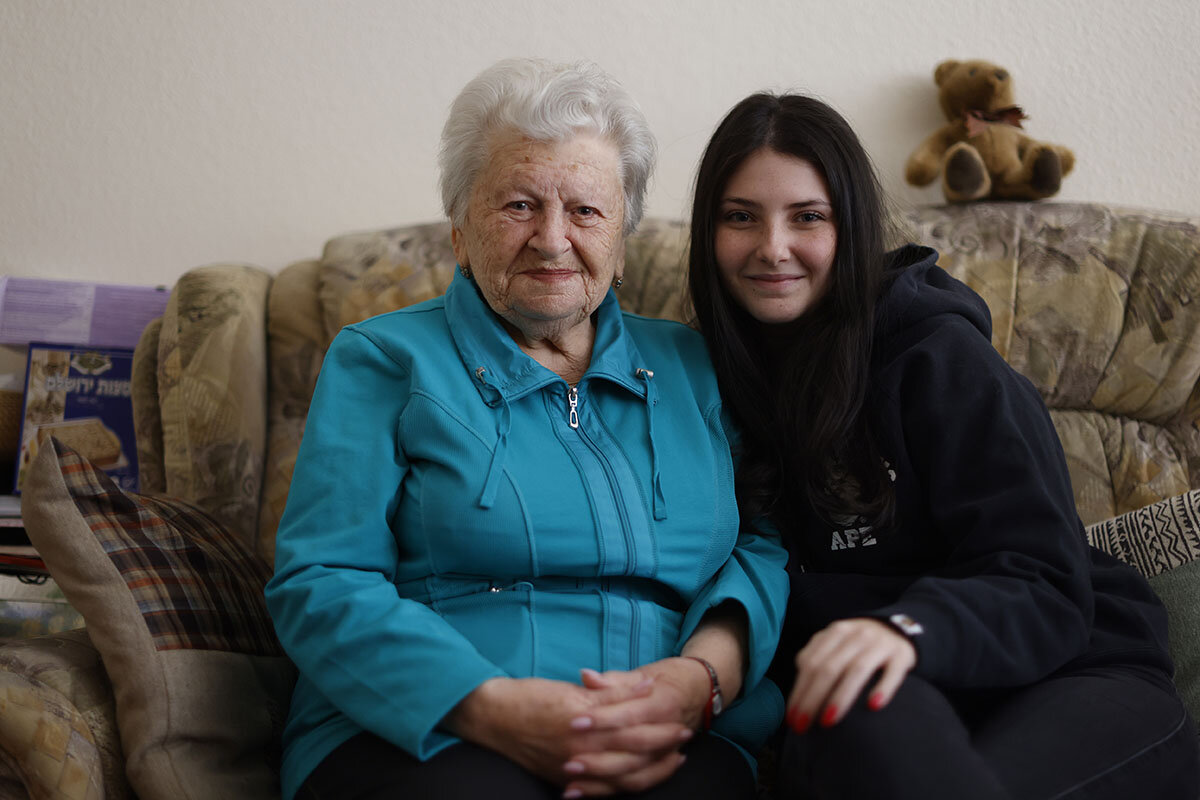
Yet the good intent of German “reparations” has real limitations. Holocaust survivors and their advocates say the process of justice for historic harm is far more complicated, even when the commitment to justice is enormous – both in intent and in material compensation. Financial support, once rejected by survivors, can never bring closure, they say, especially as antisemitism still exists and is rising following the start of the Israel-Hamas war. As states and countries from California to the United Kingdom grapple with how to leverage reparations to address generations of trauma and poverty for slavery, colonization, genocide, and state policies of exclusion, Germany’s case illustrates just how complex is the idea of addressing massive past wrongs.
“Justice is too big a word, so we don’t use it,” says Rüdiger Mahlo, representative of the Conference on Jewish Material Claims Against Germany, in Europe, the nonprofit responsible for speaking for survivors and negotiating payments with the German government.
Evolution of survival
Most survivors alive today were children during the Holocaust.
The challenges they faced after the end of World War II were numerous, says Berlin-based Holocaust historian Verena Buser. They included post-traumatic stress disorder from losing family members, growing up in hiding, or dealing with post-war poverty. “On a psychological or psycho-social level, they suffer from fears; they lost their trust in others,” she says. “All these issues come back as you age.”
There are an estimated 245,000 Jewish survivors of the Holocaust era left.
Germany has made some form of payments to survivors since the 1950s, when the Claims Conference first began negotiating on behalf of survivors and administering the resulting payments. The payments include direct compensation and home care services. Last year’s negotiation resulted in $1.4 billion for 2024, with additional one-time funds for some of the poorest survivors – largely Jews from the former Soviet Union who fled the Nazi mobile killing units tasked with eliminating entire Jewish communities.
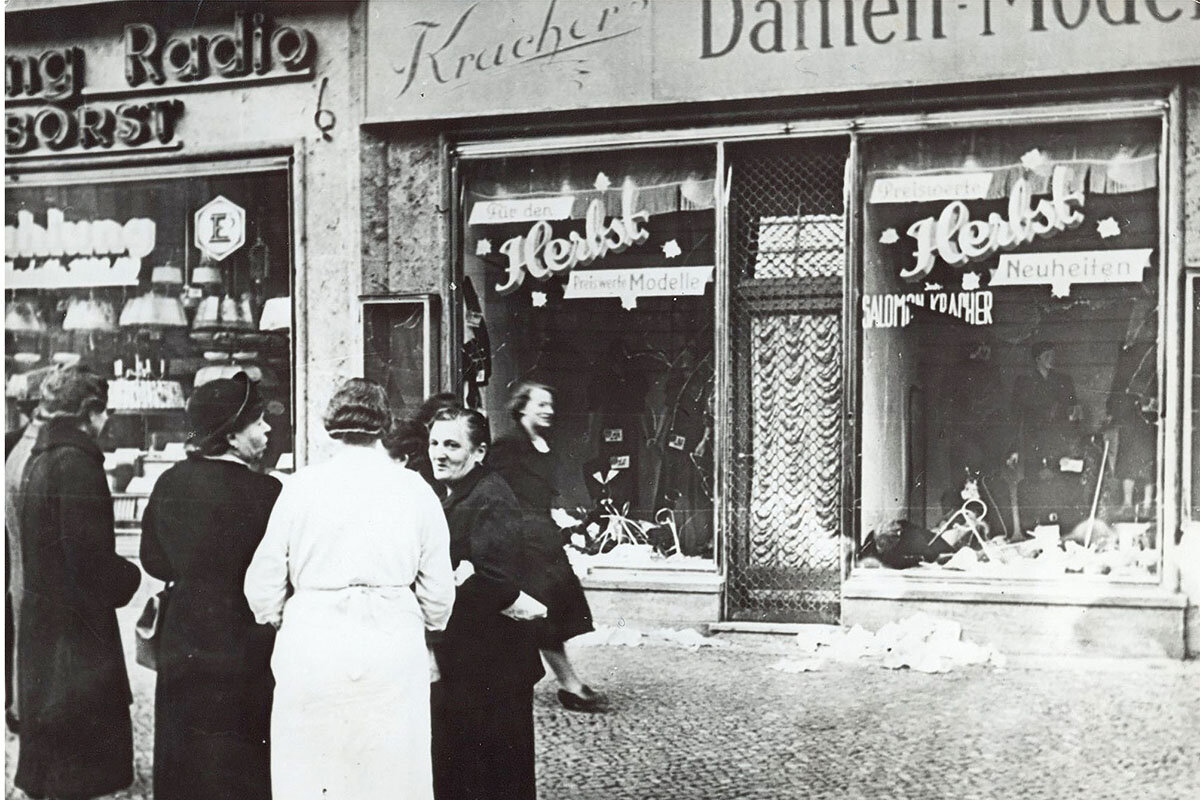
Initially, there was a chasm between how the government and survivors saw such agreements, says Mr. Mahlo of the Claims Conference. “In the beginning, survivors said, ‘What is my father or sister worth? How can you possibly morally negotiate those kinds of things?’ So we didn’t,” says Mr. Mahlo.
At first, Israel didn’t want to sit down at the negotiating table, viewing payment as an easy route to making amends. Meanwhile, in 1951, only 11% of Germans supported their government having talks with Israel. Germans today still use the term wiedergutmachen, or to “make one whole again,” but that is a framing that didn’t work for survivors amid such loss, says Mr. Mahlo.
Over 70 years later, however, there is a general consensus that Germany owes its survivors, and those payments are critical to a society’s path forward.
Leon Weintraub, a 98-year-old resident of Stockholm, survived Ghetto Litzmannstadt, Auschwitz-Birkenau, and three other concentration camps before he was liberated by the French Army in April 1945 at the age of 19, diagnosed with typhus.
During the Holocaust, three of his sisters survived Bergen-Belsen, but everyone else in his immediate family was killed. He worked hard to earn a medical degree and established himself as a doctor in Poland. During a wave of antisemitism there in the 1960s, he started over in Sweden, where he now lives.
Today Dr. Weintraub gives speeches around the world educating the public about the Holocaust. He says payments for some survivors can be of substantial help, especially for older adults in Israel who are living out their last days in very poor conditions, says Dr. Weintraub, who himself receives €1,800 quarterly. “These payments ... are a little help but still very important for them.”
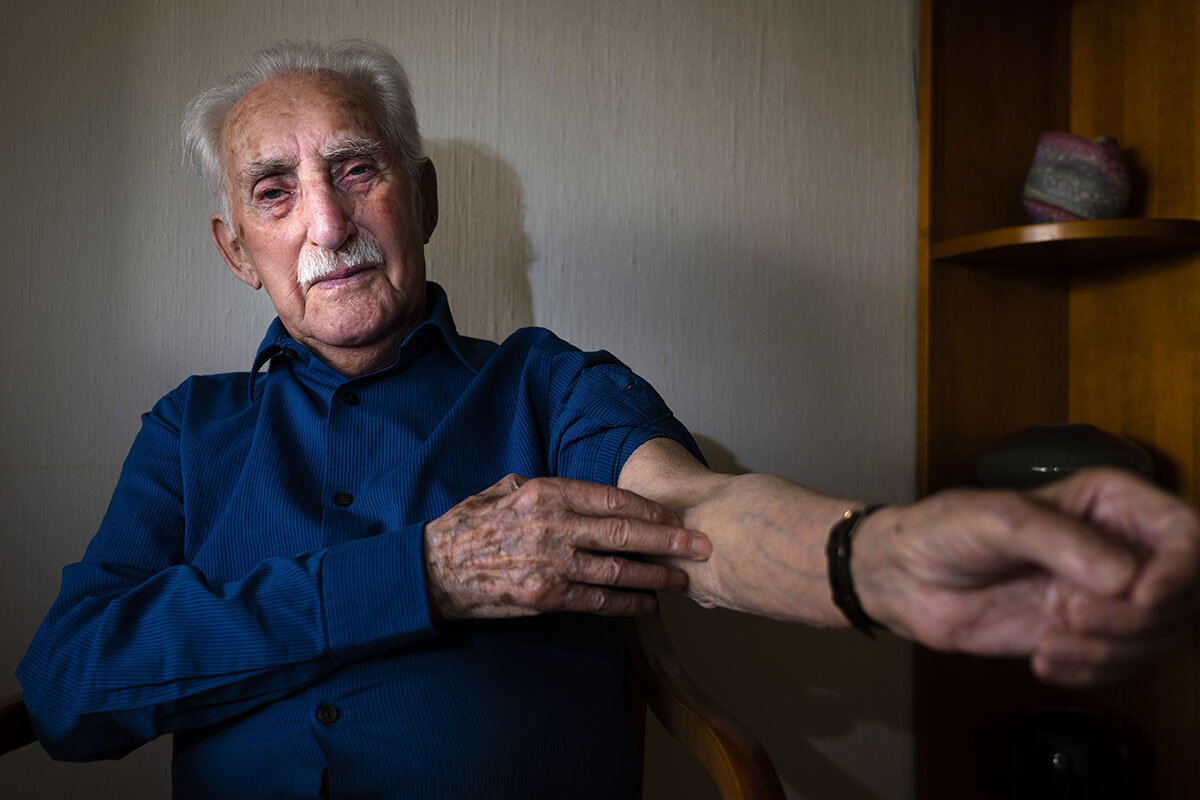
In the face of such trauma, he says, the commonly used term “reparations” is not the right word. “Because there’s no price for human life. It’s economic and financial support for survivors, to help them in their lives after surviving a terrible experience of living daily with [the prospect of] death,” says Dr. Weintraub, who retired as an obstetrician-gynecologist.
Still the payments are gestures heavy with meaning: “The German government has recognized the guilt of Germany as a state, country, nation,” he says. “That is their responsibility to continue to pay. It is the minimum Germany can do to help the few survivors.”
Evolution of victimhood
Indeed, what Germany has done especially well, says Hilary Earl, a historian of Germany and professor at Nipissing University in North Bay, Ontario, is to acknowledge that the German state was the main perpetrator in the crimes committed against Jews.
Contrast this, she says, with the Armenian genocide of 1915, for which the Turkish state has never taken responsibility.
Justice takes many forms, and means different things to different survivors, says Dr. Earl. “It is education policy, and an education system that encourages German students to study and learn about the history of World War II and the Holocaust. It is immigration policy, it is ongoing transfer payments made to the state of Israel, it is cultural policy that dedicates money to commemorative events, and it is a government that enables open access to all historical documents that relate to this period. There are so many examples.”
But justice for the past is also issued in the present – and perceptions of obligation and responsibility evolve in modern contexts.
Dr. Weintraub continues to speak publicly about the need to criminalize far-right ideologies. “Because, knowing about what happened, it’s our responsibility to make sure this never happens again,” he says. On Oct. 7, Dr. Weintraub was in Tel Aviv and awoke to the sound of sirens. He says he has been re-traumatized by Hamas’ attacks on Israel and by the feeling that he needs to again hide in the face of antisemitism. He is fearful of future genocides of Jewish people.
Though Hamas attacked Israel, the public discourse has shifted in recent months as Israel wages war in Gaza. People increasingly are questioning how Israel, a country born out of the Holocaust, could itself undertake a campaign in Gaza that is causing such devastating violence to civilians.
Dr. Karn, the Holocaust historian, says that Israel and the Palestinian territories are both home to “two deeply traumatized peoples.”
“And while these cycles of violence play out, the categories of perpetrator and victim are sometimes blurred or even collapsed,” he says. “A group that has received reparations in the past or a group that may be entitled to reparations does not automatically achieve any kind of moral purity on the basis of their losses.”
Yet no matter the current state of affairs, he sees a persistent demand for redress, not just from victims but for society overall. “The important thing is that the democratic state has to deliver a concept of justice to its citizens in order to be viewed as legitimate – not only to its citizens but also in the international arena as well.”
This story was produced as part of a special Monitor series exploring the reparations debate, in the United States and around the world. Explore more.
Editor’s note: The story was updated to correct Mr. Weintraub’s current age and details of his liberation from captivity during World War II. The story was also updated to correct what percentage of Germans in 1951 thought the German government should have talks with Israel. Further, additional context was added to the story to illustrate Mr. Weintraub’s experience as a Holocaust survivor and to include detail about the Oct. 7 attacks from Hamas while he was in Tel Aviv.

Why American shrimpers face extinction
American shrimp boats are being made obsolete by foreign shrimp farms, many with dubious practices. To survive, boat captains will need to reinvent themselves as innovators and entrepreneurs.

- Quick Read
- Deep Read ( 5 Min. )
From Brownsville, Texas, to Harkers Island, North Carolina, hundreds of shrimp boats remained dockside this year. The problem hasn’t been a lack of shrimp or the price of diesel. Instead, freezers across the United States are filled to the gills with a glut of imported shrimp.
American shrimpers can’t compete with overseas rivals who grow shrimp in farms known as aquaculture. And the trend hurts more than shrimpers. Much of the overseas aquaculture industry is damaging to the environment. Yet it’s likely here to stay.
But there are potential ways forward. Other fisheries troubled by the same trends have found success with new premium markets, safer and more professional methods, and good prices – albeit with fewer boats.
“You need to be both a farmer and entrepreneur if you want to succeed,” says Frank Asche, an economist at the University of Florida in Gainesville. “And in some sense, that’s the challenge of the U.S. shrimp fleet.”
Why American shrimpers face extinction

On a chilly December morning, the captain of the Miss Patti is ready to throw his lines and go shrimping – well, almost. Brian Jordan’s deckhand is in a foul mood, and it’s no wonder why. Is any of this worth it?
Here on the tiny working waterfront of Tybee Island, Georgia, the hesitancy is logical. Shrimp prices cratered during the past year, and hundreds of boats from Brownsville, Texas, to Harkers Island, North Carolina, remained dockside.
The problem hasn’t been a lack of shrimp or the price of diesel. Instead, freezers across the United States are filled to the gills. A glut of imported shrimp has dropped the price to about half of what shrimp boats received in the 1980s.
At stake is the livelihood of Mr. Jordan and shrimpers like him nationwide. They can’t compete with overseas rivals who raise and harvest shrimp in lower-cost “aquaculture’’ farms. There, baby shrimp essential to the marine life food chain are raised in artificial saltwater ponds, then harvested in bulk and sold for reduced prices around the world.
Because shrimp is the most valuable marine product traded in the world today – growing from a $10.6 billion industry in 2005 to over $60 billion in 2022 – the shift is consequential on many fronts. The practice is generating substantial income for developing countries such as Thailand, Indonesia, India, Vietnam, Brazil, Ecuador, and Bangladesh.
But the trend, some experts say, hurts more than just seafaring boaters like Mr. Jordan: Much of the overseas aquaculture industry is damaging to the environment, they say.
The average annual per capita consumption of shrimp in the U.S. is now at 4 pounds.
According to the World Wildlife Fund, it takes three to six months to raise market-sized shrimp, with many farmers growing two to three crops per year. Pollution from these farms, most of which are in tropical climates, is substantial, dumping organic waste, chemicals, and antibiotics into groundwater and estuaries, and salt into agricultural land. At the same time, the reality is that aquaculture is likely here to stay, and can be done in more responsible ways. The U.S. shrimping industry that survives will likely look quite different from what has existed for generations. The question is how shrimpers will adapt and innovate to change with the times.
“You need to be both a farmer and entrepreneur if you want to succeed,” says Frank Asche, a natural resource economist at the University of Florida in Gainesville. “And in some sense, that’s the challenge of the U.S. shrimp fleet.”
“Implied fraud”
For Mr. Jordan, the shrimp market of today is what he refers to as “implied fraud.”
“The consumer sees a picture of a shrimp boat and some nets hanging there, and they assume that the shrimp are from America,” he says. “And for the most part, they are not.”
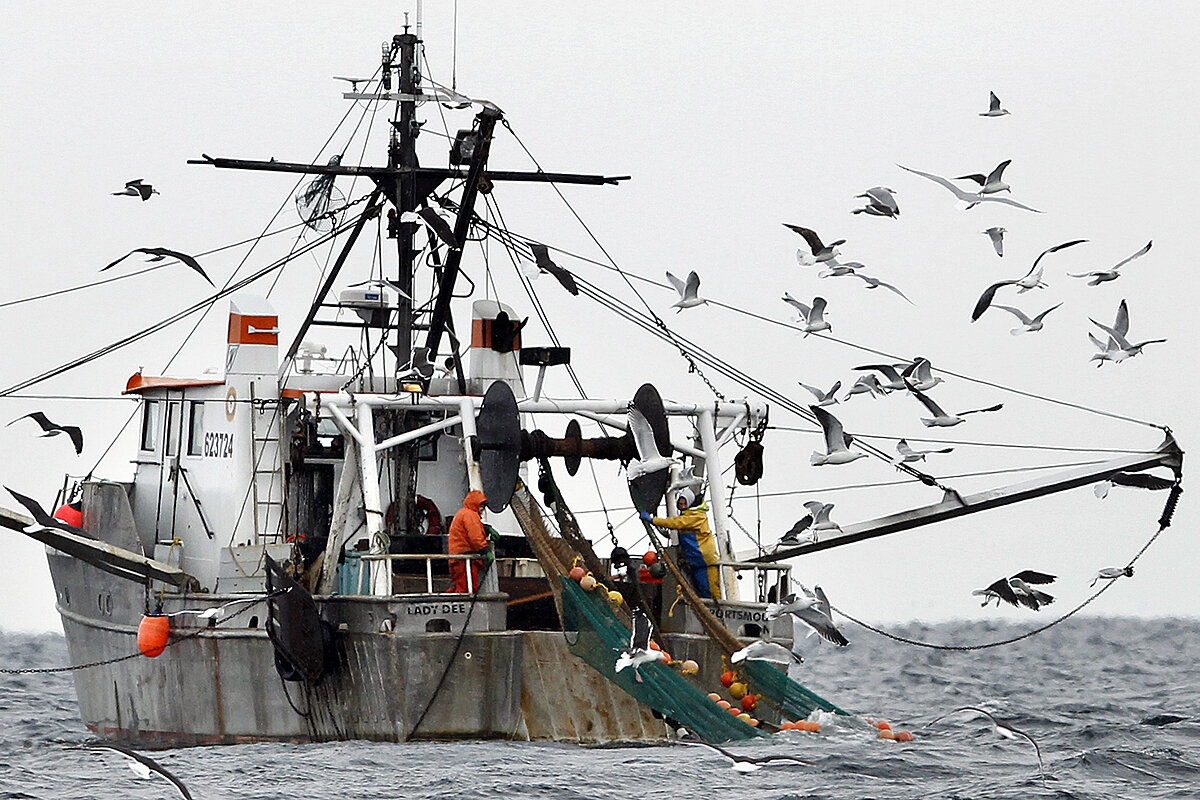
The growth of aquaculture has more than halved the U.S. shrimp fleet since the 1990s. Today, less than 10% of the domestic supply is wild-caught U.S. shrimp. And the trend hasn’t hit just shrimpers. Fisheries from salmon to catfish have been affected as aquaculture farmers fine-tune their processes, products, and prices.
Concerns about global aquaculture are varied. There is documented use of slave labor and the application of antibiotics and herbicides to farm ponds. Aquaculture operations have also been known to clear-cut mangrove swamps – the nurseries of many ocean species – to make room for shrimp ponds.
“It’s very difficult to know where your shrimp is coming from,” Ryan Bigelow, of the initiative Seafood Watch, told the FoodPrint blog.
But the industry is also fragmented. Products grown more ethically tend to be sold in Europe and the U.S., while products that don’t meet those standards are sold in less-advanced economies where aquaculture has boomed, says Professor Asche.
“That is putting on that slow pressure for the wild fishers,” he says. “That’s the main driving force.”
And it’s not just American shrimp boats falling prey. American attempts at aquaculture are struggling to compete, too.
Some 100 miles from the Gulf of Mexico, David Teichert-Coddington grows shrimp in two dozen ponds drawn from the Eutaw Reservoir in Boligee, Alabama. The water is saline enough, when amended with other minerals, to grow shrimp and grow them fast.
He can say his shrimp are U.S. grown. But that market, too, is flooded. Meanwhile, Ecuadorian shrimp are clean, well-packaged, and tasty, he says. As a result, Mr. Teichert-Coddington may leave his ponds empty next year.
“What you run into is, ‘Yeah, I like the story and the product, I’d love to buy it, but what’s the price?’” says the former university professor, who started Greene Prairie Aquafarm 23 years ago. “That it’s chemical-free and a USA product almost always just doesn’t matter. Their pocketbook talks first.”
Glimpses of the future
Mr. Teichert-Coddington is in the same boat as Tommy Faulkner, another Tybee Island captain. To Mr. Faulkner, reframing the industry from fiercely independent seafarers to savvier domestic resource harvesters is part of a necessary shift. That could unlock federal aid.
“At the end of the day, my boat is a sea tractor and we’re farmers who go out and harvest a crop,” he says.
“There’s no one solution,” adds Paige Morrison, executive director of the Georgia Commercial Fisherman’s Association in Savannah. “It’s going to take legislation, it’s going to take support and awareness and education, it’s going to take a new marketing system – a whole new business model.”
But there are potential ways forward.
The World Wildlife Fund, for one, is working to develop enforceable standards that reduce negative environmental and social impacts and ensure quality and safety, while improving aquaculture practices through tech innovations like forensic analysis of farmed products. The group is also working to encourage practices that help traditional shrimpers still make a living.
And a new red snapper fishery in the Gulf of Mexico, for example, has found success with new premium markets, safer and more professional methods, and good prices – albeit with fewer boats.
“I think what we’re looking at is a system in transition and where it is going depends,” says Phil Loring, author of “Finding Our Niche: Toward a Restorative Human Ecology,” and a food systems expert at The Nature Conservancy. “With the right nudges, it could be really something that features the character of local and regional food, supports a blue-collar culture, and supports working waterfronts that people like to see.”
Editor’s note: In a sentence about price declines, a time reference has been corrected to encompass 2023.

Difference-maker
From dentures to job training, ex-prisoners get help to thrive
Miles of Freedom helps people leaving prison. The most important thing it offers: community.
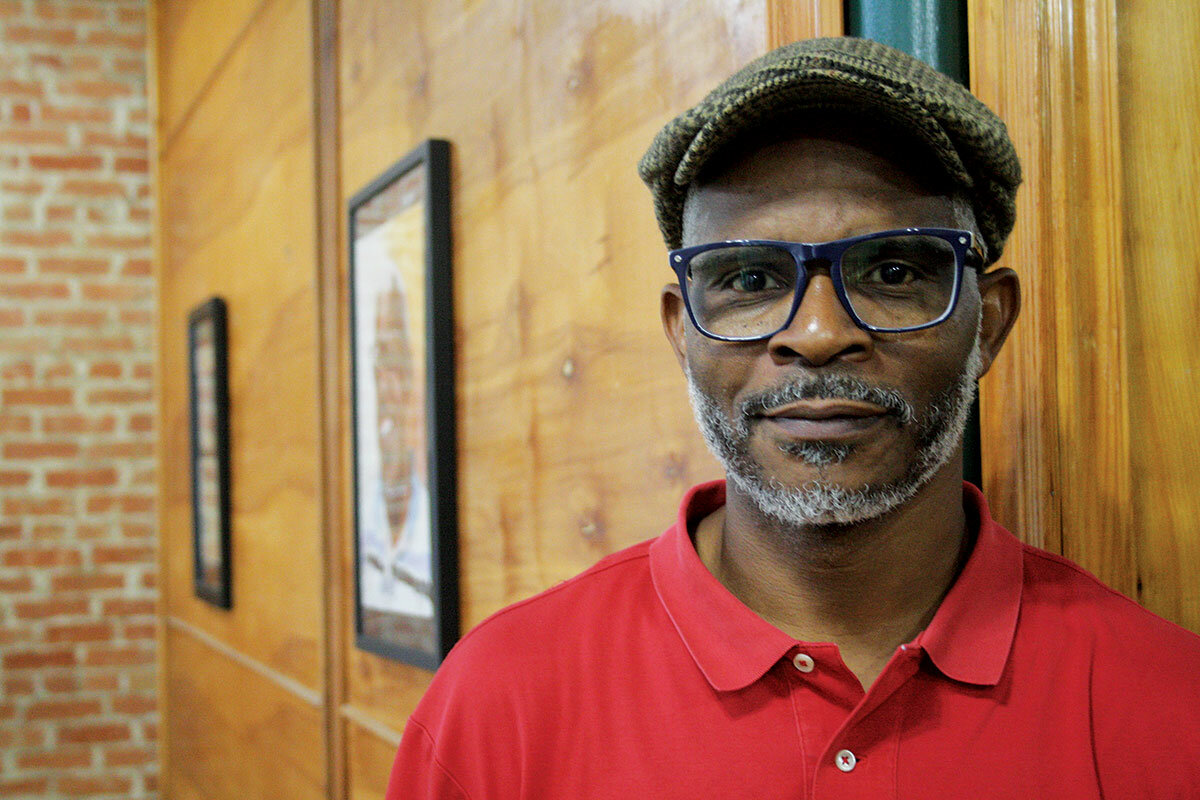
- Quick Read
- Deep Read ( 5 Min. )
Richard Miles knows the deep injustice of a wrongful conviction. But he also knows the broad injustice felt by the thousands of people who are released from America’s prisons each day.
That’s why he helped found the Texas nonprofit Miles of Freedom.
“Innocent or guilty, coming home, we need help,” says Mr. Miles, who was wrongfully incarcerated for murder before being exonerated 11 years ago.
In Texas on an average day, more than 1,600 people come home from prison. The state gives them a set of clothes, $50, and a bus voucher. Mr. Miles knows that’s not enough to rebuild a life. Miles of Freedom, which has 13 full-time employees besides Mr. Miles, offers jobs through the group’s lawn service, plus job training and food through its pantry. The group helped one man get a drive shaft so he could fix his car. It got another man free dentures.
Jay Dan Gumm, a formerly incarcerated man who founded Forgiven Felons, another Texas organization that supports reentry into society, says, “It’s about all of us collaborating to fill in the gaps.”
From dentures to job training, ex-prisoners get help to thrive
The defining years of Richard Miles’ life weren’t the 15 he spent wrongfully incarcerated for murder. They haven’t been the 11 years since his exoneration, either. What has defined his lifework has been the 30 months between the two.
It’s that period, when he was just another guy who had served time struggling to rebuild his life, that inspired him to help found Miles of Freedom. He could have focused his efforts on other wrongful convictions, as other exonerees have done. His home state of Texas, after all, has more exonerations than almost any other. But while he knows better than anyone the deep injustice of a wrongful conviction, he also knows better than most the broad injustice felt by the thousands of people who are released from America’s prisons each day.
“We started Miles of Freedom not because I was innocent, but because I was in prison,” he says. “I felt that there was a larger problem than the social injustice of wrongful conviction. Innocent or guilty, coming home, we need help.”
In Texas on an average day, north of 1,600 people come home from prison. The state gives them a set of clothes, $50, and a bus voucher. Mr. Miles knows that’s not enough to rebuild a life.
What formerly incarcerated people need as much as anything is a stable job, and that’s what Miles of Freedom works to provide in Dallas.
The organization offers jobs, job training, and resources. Mr. Miles estimates that he and his 13 full-time employees have helped around 2,600 men and women. They offer jobs through the group’s lawn service and food through its food pantry. They helped one man get a drive shaft so he could fix his car. They got another man free dentures.

“For someone who’s been wronged by the system, beat up by the system, to want to give back just shows what kind of man he is,” says Jay Dan Gumm, a formerly incarcerated man who founded Forgiven Felons.
The justice system “seems to not want to make it easy. They actually make it harder on us,” he adds. “It’s about all of us collaborating to fill in the gaps.”
Help for those with no one
Corina Bernal went decades without help.
When she first went to prison, she was a pregnant teenager. She gave birth to her second daughter while incarcerated. Over the next 30 years, she cycled in and out of prison. She struggled to hold down jobs. With no family to turn to, when she got in a tough spot she would start selling drugs. “It’s hard for me to shake it off and get out,” says Ms. Bernal.
“I’m not going to be broke. I’m not,” she adds. “It shouldn’t affect me that much, but it really does because I don’t have family.”
Near the end of her most recent sentence, she heard from another imprisoned person about Miles of Freedom. About six months later, on a rainy November morning, she’s celebrating getting a driver’s license. She’s been working part time at the lawn service, but now that the crucial hurdle of getting an ID has been overcome, she’s eyeing the future. Her next goal is to open a bank account, and then get a permanent job at Miles of Freedom. Long-term, she wants to work as a truck driver.
“Just having a support system, that’s [what is] good with Miles of Freedom,” she says. “Also, what’s helpful is the people that you work around are very positive people.”
Indeed, as necessary as it is to teach formerly incarcerated people how to put together a résumé and make a budget, the most important thing Miles of Freedom provides is a community.
Mr. Miles knows he was more blessed than most in the support he got returning home after prison. But because he had still been convicted of a crime, he struggled to find housing and a job. A minister at his church found him work at a hotel, and a childhood friend co-signed on an apartment.
“Reentry, bottom line, is about building relationships,” says Mr. Miles.
But that can be difficult for someone coming out of prison. In prison “you become a recluse,” he says. You learn to never reveal much of what you’re thinking or feeling in case it sparks an altercation.
“The hardest part of my transition was talking about the things that I was going through, talking about how lost I was, talking about how hurt I was,” he adds.
“We have people that came here [who’ve] done 36, 37 years, and when they come [in], the relationship that they’re met with knocks them off guard,” he continues. “When they feel that, not having a place to stay, not having a job is bearable.”
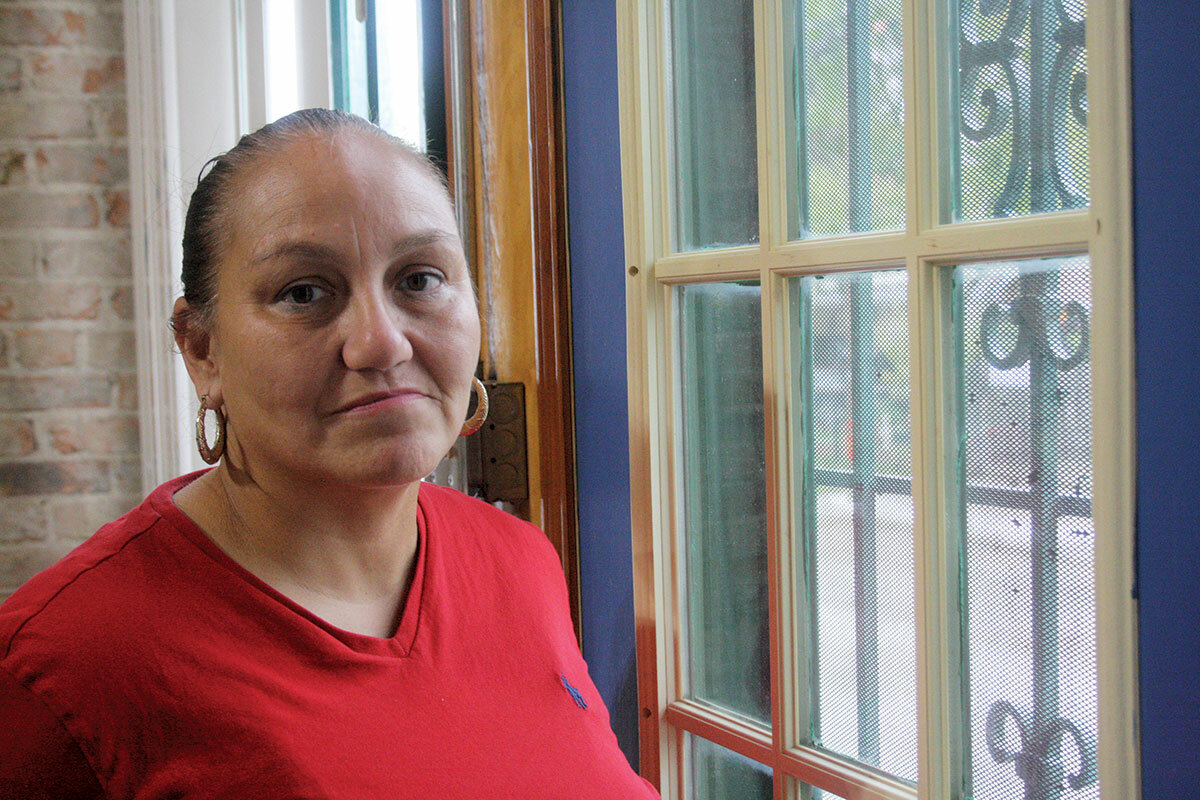
A patched-together system
About 30% of U.S. nonprofits fold within 10 years. Celebrating its 11th anniversary, Miles of Freedom has the traits of a group that’s in this for the long haul.
The organization has multiple offices and over a dozen permanent employees managing casework. No one who makes an appointment is turned away. Those who have issues the nonprofit isn’t equipped for – substance abuse, for example – are referred to organizations with more expertise.
Over the past decade, Miles of Freedom has become a valuable part of an informal, largely nonprofit-
driven network of reentry service providers in the Dallas area.
“The beauty of the relationship that we have with Miles of Freedom is we supplement what Richard is doing,” says Annette Jenkins of One Man’s Treasure, a nonprofit that provides free clothing – from shirts and pants to suits and work boots – to men released from prison.
Compared with the court system and the prison system, there’s very little government presence in the reentry space. In Texas, for example, the state Department of Criminal Justice spent $200 million on parole and reentry, according to the most recent budget. It spent over $3 billion on incarcerating people.
This lack of investment in reentry has public safety consequences, experts say.
A 2021 study by the U.S. Bureau of Justice Statistics found that within 10 years of release, 62% of prisoners are back in prison. What many people need is a foothold in society they can use to build a healthy and law-abiding life, says Ms. Jenkins.
“Every time that happens, then communities are safer,” she adds. And the benefits can last lifetimes. “It’s a short-term solution for that immediate [person], and long-term for their family. It’s generational.”
One in 3 adults in the United States have a criminal conviction, according to a 2021 report from the Alliance for Safety and Justice. In Texas, it’s 1 in 2. The burden of rehabilitating those who go through the criminal justice system has largely fallen on this patchwork of family, community, and nonprofit supports.
Because of these holes in the system,
Mr. Miles believes, justice remains elusive for people who have paid their debts to society.
“We close our eyes and allow this system to autonomously run. That’s where we have wrecks and casualties,” he says.
“Justice is not [inherently] in the system; it’s what we want to come out,” he adds. “Even for [a guilty] person. We want that person to come out just.”
Other headline stories we’re watching
(Get live updates throughout the day.)The Monitor's View
The password for generosity: Trust
- Quick Read
- Deep Read ( 2 Min. )
-
By the Monitor's Editorial Board
For more than a decade, Airbnb has donated millions to charitable causes, sometimes with help from the hosts who rent out properties on the booking platform. The goal of these grants has been to “unlock the creative power” of hospitality based on the idea that generosity evokes emulation and is intrinsic to each individual. This year, the company’s nonprofit arm tried something different.
It allowed a board representing hundreds of Airbnb hosts to select projects in their communities worthy of a donation. That extension of trust to the hosts was widely admired in the philanthropic world as one way to create ripples of giving. Last week, the company donated $10 million to more than 120 nonprofits in 44 countries.
Trust, it turns out, can have significant influence on generosity, according to a report this month by the Do Good Institute at the University of Maryland. Relying on data from the U.S. Census Bureau, the institute found that trust in others, particularly neighbors, encourages people to participate in community groups and civic organizations, leading to higher rates of giving and volunteering.
The password for generosity: Trust

For more than a decade, Airbnb has donated millions to charitable causes, sometimes with help from the hosts who rent out properties on the booking platform. The goal of these grants has been to “unlock the creative power” of hospitality based on the idea that generosity evokes emulation and is intrinsic to each individual. This year, the company’s nonprofit arm tried something different.
It allowed a board representing hundreds of Airbnb hosts to select projects in their communities worthy of a donation. That extension of trust to the hosts was widely admired in the philanthropic world as one way to create ripples of giving. Last week, the company donated $10 million to more than 120 nonprofits in 44 countries.
“It’s important for us to be stewards of our community,” Nadia Giordani, who rents out a house in Atlanta and serves on the Airbnb Host Advisory Board, told The Associated Press. She was thrilled to hear how other hosts are supporting nonprofits near them.
Trust, it turns out, can have significant influence on generosity, according to a report this month by the Do Good Institute at the University of Maryland. Relying on data from the U.S. Census Bureau, the institute found that trust in others, particularly neighbors, encourages people to participate in community groups and civic organizations, leading to higher rates of giving and volunteering.
Being a member of a religious congregation has the largest influence on individual philanthropy. And the report notes this: “The Internet age has prompted dramatic changes in the importance of community organizations and informal groups in people’s lives – and the pandemic has caused even more profound changes to the way people engage with groups.”
The idea that kindness begets kindness was reinforced this week by this new finding from the Christian research group Barna:
More than half of U.S. adults who reported making charitable donations within the last year (54%) said they have received “extraordinary generosity from others,” compared with only 36% of nongivers.
A similar theme is found in a new book by Chris Anderson, the curator of TED Talks for 23 years during which he put the world’s top thinkers and doers on a stage in front of a camera for anyone to listen to.
The book, entitled “Infectious Generosity: The Ultimate Idea Worth Spreading,” is based on his revelation that generosity is “the essential connecting thread between the most important lessons” he’s ever learned.
“It’s not just about giving away money. Simply adopting a generous mindset can make a difference. That can lead to gifts of time, talent, creativity, connection, and basic human kindness,” he writes. These gifts “have the potential to create amazing chain reactions.”
He provides an example of reaching out with compassion to listen to those with whom we disagree on issues. “If you’re successful, there’s a powerful knock-on benefit: You are helping change the tone of public discussion today. That’s a gift to all of us.” Trust wins. Again.

A Christian Science Perspective
Each weekday, the Monitor includes one clearly labeled religious article offering spiritual insight on contemporary issues, including the news. The publication – in its various forms – is produced for anyone who cares about the progress of the human endeavor around the world and seeks news reported with compassion, intelligence, and an essentially constructive lens. For many, that caring has religious roots. For many, it does not. The Monitor has always embraced both audiences. The Monitor is owned by a church – The First Church of Christ, Scientist, in Boston – whose founder was concerned with both the state of the world and the quality of available news.
Loneliness? There is a better companion.
- Quick Read
- Read or Listen ( 3 Min. )
-
By Elizabeth Mata
Leaning on the eternal promise of “God with us” brings richness and fullness to our lives – whether we’re alone or with others.
Loneliness? There is a better companion.
Maybe this has happened to you: Someone on the street smiles at you and you smile back. Or the other way around. My favorite is simultaneous smiles between a stranger and me, as though some shared good moved our hearts at the same moment. In any case, such moments – however brief – indicate to me that being connected to others is completely natural and available for all of us.
Around the world, efforts are being made to combat loneliness and isolation. For instance, the United Kingdom and Japan have established Ministers of Loneliness, and some countries have set up “happy to chat” benches in public places to encourage conversations among strangers. It’s encouraging that this issue is being taken to heart.
Whether loneliness comes as a sense of isolation from others or as a feeling of separation from purpose and meaning, at its root is the notion that we are lacking something essential to our wholeness and bereft of opportunities to give and receive good. I’ve found that turning to God in prayer is a vital way to arrive at healing solutions for well-being and completeness, including meaningful relationships and activities.
Allowing the divinely directed desire to bless others and glorify God to gently replace a human striving to change the human scene, is a tremendous help in lifting thought and gaining freedom from loneliness. This inspired frame of thought enables us to drop material reasoning and lights the way forward as we sincerely and expectantly seek divine guidance.
The phrase “God with us” has been helpful to me in praying about loneliness. It’s from a passage in the Bible prophesying Jesus’ birth: “Behold, a virgin shall be with child, and shall bring forth a son, and they shall call his name Emmanuel, which being interpreted is, God with us” (Matthew 1:23).
The teachings of Christian Science, which are firmly grounded in the Bible, bring out the spiritual import of biblical truths, making them very applicable to daily situations. Mary Baker Eddy, the discoverer of Christian Science, highlights the profound significance of “God with us” in her primary work, “Science and Health with Key to the Scriptures,” when she writes of “the revelation of Immanuel, ‘God with us,’ – the sovereign ever-presence, delivering the children of men from every ill ‘that flesh is heir to’” (p. 107).
How powerful this is when we consider another passage from Science and Health that describes “God with us” as “a divine influence ever present in human consciousness” (p. xi). This influence – Christ – was the basis of all the good, healing, and transformation that Jesus brought to others as he ceaselessly lived “God with us.” Jesus showed us that through the eternal Christ, each of us can feel moment by moment the “sovereign ever-presence” of divine Love and Truth right here with us, healing and bringing abundant blessings to all, just as it did during Jesus’ time.
The powerful spiritual fact of “God with us” is a solid basis for praying about loneliness. Christian Science teaches that God – divine Love, ever-present Spirit – is our divine Parent. Therefore we are the preciously cared-for sons and daughters of Spirit – each one of us spiritual and complete with every useful quality derived from God. This divine relation, in which we are the reflection of Love, is indissoluble and eternal.
It is so natural to feel the harmonious spiritual reality of our unity with God, and therefore with each other as brothers and sisters. This enables us to freely share our innate kindness and joy with whomever we meet. We can rule out as illegitimate any sense of separation from good, because such separation is not possible in God’s creation. This results in more consistently feeling His goodness right with us. And as we’re receptive to the spiritual reality of everyone’s inherent completeness, this brings into our experience all that fully enriches, inspires, satisfies.
I have found over many years that praying to feel embraced in the tenderness of God’s presence causes life to blossom with meaningful relationships and activities. And it fills my moments of solitude with sweetness.
“God with us” is the reality right now. As we welcome this companioning every moment of the day – no matter who’s there or not there – we’ll find that it begins to shape, fill, and bless our lives.

Viewfinder
Standard-bearers

A look ahead
Thank you for joining us today. We hope you’ll come back tomorrow when we look at Israel’s Druze, a religious group that says whatever differences they had with Israeli Jews have disappeared since Oct. 7.


